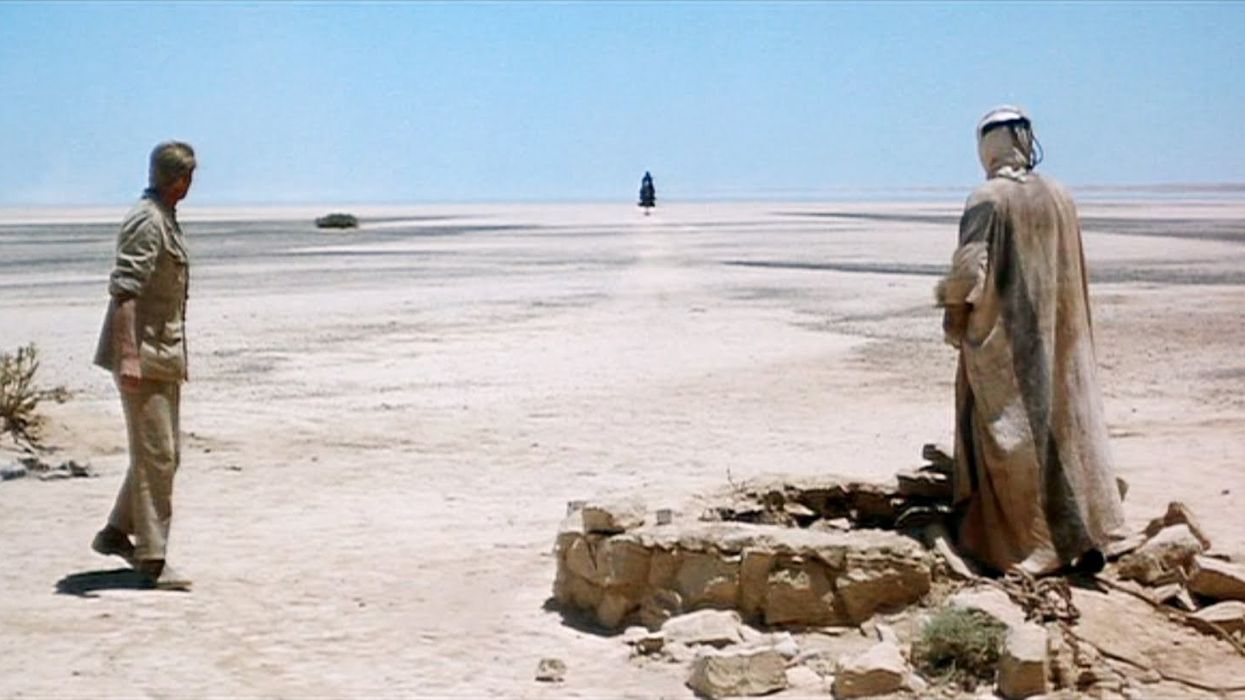Watch: How a Legendary 'Lawrence of Arabia' Scene Creates Nearly Unbearable Suspense
Diegetic sound played a key role in one of the most famous scenes from one of the most famous movies of all time.

Writing about the 1962 David Lean film that followed the exploits of real-life British writer and explorer T.E. Lawrence, Roger Ebert quoted one of the film's stars, Omar Sharif, who recounted the improbability of the film's existence: “If...somebody comes to you and says he wants to make a film that's four hours long, with no stars, and no women, and no love story, and not much action either, and he wants to spend a huge amount of money to go film it in the desert—what would you say?”
Well, producer Sam Spiegel and his influential Horizon Pictures said yes, and the result is currently #7 on the AFI's list of the 100 Greatest American Films of All Time. This video from Cinema Tyler breaks down one of the most famous moments in the film, the visually stunning "Ali's well" scene.
One of the wonderful things about the scene is that, well, not much happens, and yet, the suspense is nearly unbearable. Really, though, all that happens is that Omar Sharif's character, Ali, spends nearly two minutes materializing out of a desert mirage, before shooting the man who has dared to drink from his well, and then introduces himself to Lawrence. It's a pivotal moment in the film, introducing an entirely new thread of action, and it also serves to highlight the majesty and almost unfathomable space of the environment, captured so masterfully by the cinematography of F.A. Young.
The film's editor, Anne V. Coates, during a discussion at last year's Sight, Sound & Story event, remarked that one striking element of the scene is that it breaks from the Hollywood film tradition of using "all sorts of suspenseful music cues," instead relying on diegetic sound, a decision made in editing by Coates and Lean. The lack of a cue works well because it doesn't prime the audience to feel one way or the other; instead of music, one of the only sounds in the scene before Sharif's arrival, and the gunshot, is the steady, rather calm, rhythm of Ali's trotting horse (Interestingly, the hoof beats don't increase in volume as the horse gets closer, but remain at a relatively soft level, a decision which breaks with "real" life in favor of a cinematic reality.)
"Everyone had said that a mirage wouldn't photograph...but one day while on a mudflat I took out my Hasselblad and there it was, a mirage." —David Lean
Another little-known fact about the scene comes from Tyler's recounting of an exchange between director Lean and cinematographer Freddie "F.A." Young. Lean had said to his cinematographer, "I don't know how in bloody hell we'll do it, but I want a mirage. Everyone had said that a mirage wouldn't photograph, that it was an illusion of the eye, but one day while on a mudflat I took out my Hasselblad [camera] and there it was, a mirage."
After finding a suitable location, Production Designer John Box decided that the vista lacked emotion, and so he "painted white lines, about two feet wide to act as camel track's and draw the audience's attention to where Ali was coming from." As Box himself said of the track, "It's bringing that man to this place and this place is Lawrence, and Lawrence's life is going to be different after meeting this man."
This video is a really great piece of analysis, whether you've seen the film or not (and you should, really); regardless, it demonstrates the ways in which the simplest elements can be brought together to achieve startling effect, and how a character can be introduced in an indelible way through the skilfull deployment of cinematic technique, in concert (and harmony) with location and story.











